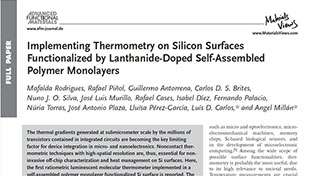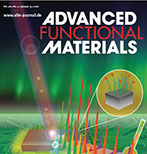


<
>
PHOTONIC HYBRIDS AND NANOMATERIALS GROUP
Aveiro-Portugal
university of aveiro
theoria poiesis praxis
physics department
ciceco
aveiro institute of materials


HOME > SCIENTIFIC OUTPUT > COVERS & RESEARCH HIGHLIGHTS










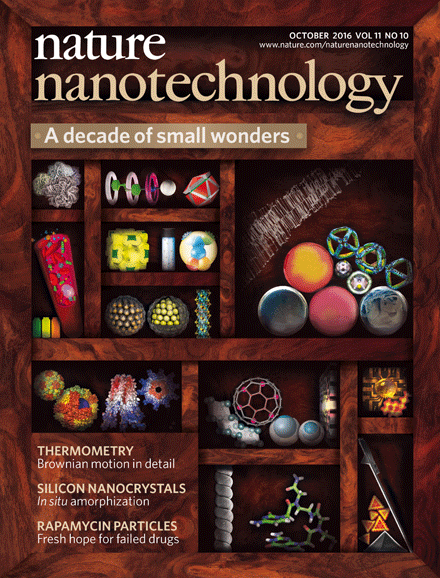















Thermal enhancement of upconversion emission in nanocrystals: a comprehensive summary
Physical Chemistry Chemical Physics
Luminescence thermal stability is a major figure of merit of lanthanide-doped nanoparticles playing an essential role in determining their potential applications in advanced optics. Unfortunately, considering the intensification of multiple electron-vibration interactions as temperature increases, luminescence thermal quenching of lanthanide-doped materials is generally considered to be inevitable. Recently, the emergence of thermally enhanced upconversion luminescence in lanthanide-doped nanoparticles seemed to challenge this stereotype, and the research on this topic rapidly aroused wide attention. While considerable efforts have been made to explore the origin of this phenomenon, the key mechanism of luminescence enhancement is still under debate. Here, to sort out the context of this intriguing finding, the reported results on this exciting topic are reviewed, and the corresponding enhancement mechanisms as proposed by different researchers are summarized.
Lanthanide Luminescence to Mimic Molecular Logic and Computing through Physical Inputs
Advanced Optical Materials
The remarkable advances in molecular logic reported in the last decade demonstrate the potential of luminescent molecules for logical operations, a paradigm‐changing concerning silicon‐based electronics. Trivalent lanthanide (Ln3+) ions, with their characteristic narrow line emissions, long‐lived excited states, and photostability under illumination, may improve the state‐of‐the‐art molecular logical devices.
This is the first report showing sequential logic and arithmetic operations combining molecular Ln3+ complexes and physical inputs. Contrary to chemical inputs, physical inputs may enable the future concatenation of distinct logical functions and reuse of the logical devices, a clear step forward toward input–output homogeneity that is precluding the integration of nowadays molecular logic devices.
Simultaneous Measurement of the Emission Quantum Yield and Local Temperature: The Illustrative Example of SrF2:Yb3+/Er3+ Single Crystal
European Journal of Inorganic Chemistry
The Front Cover shows the simultaneous measurement of the emission quantum yield and the absolute temperature by use of primary luminescence thermometry in SrF2:Yb3+/Er3+ single crystals. More information can be found in the Full Paper by C. D. S. Brites et al. For more on the story behind the cover research, see the Cover Profile.
Flexible Blue-Light Fiber Amplifiers to Improve Signal Coverage in Advanced Lighting Communication Systems
Cell Reports
Visible-light communication (VLC) based on white light-emitting diodes has recently attracted much attention to provide high-bitrate data communication in indoor environments. One of the remaining challenges to be resolved to enable the proliferation of VLC systems is related to channel attenuation and multiple path fading. Here, we introduce an advanced VLC system integrating an optical amplifier as a promising solution to overcome channel impairments, providing high bitrate coverage. The optical amplifier is a flexible fiber based on a poly(fluorene)-based lumophore doped within a di-ureasil organic-inorganic hybrid. Optical amplification is demonstrated for pre-amplifier and relay node scenarios, yielding a maximum gain of 5.9 ± 0.2 dB and 3.7 ± 0.2 dB, respectively, establishing the proposed approach as a promising cost-effective solution for VLCs. Additionally, numerical simulations show, for a realistic environment, a 207% improvement in the coverage area, using existing lighting infrastructure without extra cost.
Spectral converters for photovoltaics – What’s ahead - Review paper
Materials Today
The effective incorporation of photovoltaic (PV) elements into the urban environment, specifically in buildings, is a challenging process. Apart from the aesthetic limitations of having black and opaque PV cells when installed in building façades, they are not optimally positioned for high-efficiency electric energy generation because of shadowing effects due to neighboring trees and buildings. Emphasis is given to luminescent solar concentrators (LSCs) that have emerged as an appealing solution for concentrating a large area of sunlight into a small beam of high field intensity. The coupling of PV cells to the edges of LSCs also presents an exciting strategy to PV urban integration. Here, we outline the mechanistic framework for LSCs, review the current experimental state of the art involving optically active centers in various geometrical device configurations, and discuss the performance quantification of LSCs currently in development. For the sake of completeness, a brief discussion of the other spectral converters suitable for PV applications is also reported.
Developing Luminescent Ratiometric Thermometers Based on a Covalent Organic Framework
Angewandte Chemie
Covalent Organic Frameworks (COFs), an emerging class of crystalline porous materials, are proposed here as a new type of support for grafting lanthanide ions (Ln3+) and employing these hybrid materials as ratiometric luminescent thermometers. A TpBpy COF – prepared from 1,3,5‐triformylphloroglucinol (Tp) and 2,2’‐bipyridine‐5,5’‐diamine (Bpy) grafted with Eu/Tb and Dy acetylacetone (acac) complexes can be successfully used as luminescent thermometers in the 10–360 K and 280–440 K ranges, respectively, exhibiting good sensing properties (thermal sensitivity up to 1.403 %K‐1, temperature uncertainty 𝛿T < 1 K above 110 K). For the Eu/Tb systems we observe a quite unusual and rarely reported behavior in which there is no thermal quenching of the Tb3+emission, as a result of the absence of ion‐to‐ligand/host energy back transfer. The LnCOF materials proposed here could be a new class of materials employed for temperature sensing applications following up the well‐known Metal Organic Framework luminescent thermometers.
Making Prussian blue analogues nanoparticles luminescent: effect of the luminophore confinement over the properties
Nanoscale
In this communication, we report the post-synthetic functionalization of K+/Ni2+/[Cr(CN)6]3− Prussian blue analogue (PBA) nanoparticles by the 2-aminoanthracene luminophore to yield a bifunctional magneto-luminescent nanosystem. The photoluminescence properties of the fluorophore are found modified by the confinement effect upon adsorption, while the magnetic behavior of PBA is preserved.
Lanthanide-based downshifting layers tested in a solar car race
Opto-Electronic Advances
The mismatch between the AM1.5G spectrum and the photovoltaic (PV) cells absorption is one of the most limiting factors for PV performance. To overcome this constraint through the enhancement of solar energy harvesting, luminescent downshifting (LDS) layers are very promising to shape the incident sunlight and, thus, we report here the use of Tb3+- and Eu3+-doped organic-inorganic hybrid materials as LDS layers on Si PV cells. Electrical measurements on the PV cell, done before and after the deposition of the LDS layers, confirm the positive effect of the coatings on the cell’s performance in the UV spectral region. The maximum delivered power and the maximum absolute external quantum efficiency increased 14% and 27%, respectively. Moreover, a solar powered car race was organized in which the small vehicle containing the coated PV cells presented a relative increase of 9% in the velocity, when compared to that with the uncoated one.
Three‐Mode Modulation Electrochromic Device with High Energy Efficiency for Windows of Buildings Located in Continental Climatic Regions
Advanced Sustainable Materials
A sustainable use of energy in buildings demands energy‐efficient windows. A new design concept for electrochromic (EC) smart windows, easy to implement at the industrial level, is introduced here. It enables simultaneous control of visible and near‐infrared (NIR) solar radiation, thus contributing to reduce heating and cooling loads especially in buildings located in areas experiencing wide daily temperature ranges. The EC device comprises amorphous indium zinc oxide, a conducting oxide transparent in the visible and NIR spectral regions, as nonactive layer, and a sol–gel protonic ionic liquid‐doped di‐ureasil electrolyte displaying high transparency and proton conductivity.
Electrochromic Switch Devices Mixing Small‐ and Large‐Sized Upconverting Nanocrystals
Advanced Functional Materials
The hasty progress in smart, portable, flexible, and transparent integrated electronics and optoelectronics is currently one of the driving forces in nanoscience and nanotechnology. A promising approach is the combination of transparent conducting electrode materials (e.g., silver nanowires, AgNWs) and upconverting nanoparticles (UCNPs). Here, electrochromic devices based on transparent nanocomposite films of poly(methyl methacrylate) and AgNWs covered by UCNPs of different sizes and compositions are developed. By combining the electrical control of the heat dissipation in AgNW networks with size‐dependent thermal properties of UCNPs, tunable electrochromic transparent devices covering a broad range of the chromatic diagrams are fabricated.
Instantaneous ballistic velocity of suspended Brownian nanocrystals measured by upconversion nanothermometry
Nature Nanotechnology
Brownian motion is one of the most fascinating phenomena in nature. However, despite extensive experimental investigations, the basic microscopic knowledge of prototypical systems such as colloidal particles in a fluid is still far from being complete. This is particularly the case for the measurement of the particles' instantaneous velocities, elusive due to the rapid random movements on extremely short timescales. Here, we report the measurement of the instantaneous ballistic velocity of Brownian nanocrystals suspended in both aqueous and organic solvents. To achieve this, we develop a technique based on upconversion nanothermometry.
Encapsulation of a [Dy(OH2)8]3+ cation: magneto-optical and theoretical studies of a caged, emissive SMM
Chemical Communications
The first supramolecular cage formed by three benzo-15-crown-5 macrocycles encapsulating a [Dy(OH2)8]3+ guest cation is reported, with the Dy(III) centre exhibiting local pseudo square antiprismatic D4d symmetry. The anisotropy barrier extracted from ac susceptibility studies, emission spectroscopy and ab initio calculations reveals that the second excited state Kramers doublet plays a key role in the magnetization dynamics due to the Ising character and near coparallel nature of the ground and first excited Kramers doublets.
Cryogenic Nanothermometer Based on the MIL-103(Tb,Eu) Metal–Organic Framework
European Journal of Inorganic Chemistry
The microporous metal–organic framework MIL-103 doped with Tb3+ and Eu3+, formulated as [(Tb0.95Eu0.05)(btb)(H2O)]·(solv)x [H3btb = 1,3,5-tris(4-carboxyphenyl)benzene; solv = H2O, CH3OH] has been shown to be a good platform for luminescent ratiometric thermometry. Although operative over a wide range of temperatures (10–320 K), this material exhibits, in the cryogenic range (<100 K), one of the best performances of metal–organic frameworks, with a relative thermal sensitivity of 2.85 % K–1 at 14 K. The material exists in the form of nanoparticles, suitable for nanothermometry applications (e.g., microfluidics). Moreover, as MIL-103 is nanoporous, its use as a multisensing platform deserves further consideration in the near future.
A New Generation of Primary Luminescent Thermometers Based on Silicon Nanoparticles and Operating in Different Media
Particle & Particle Systems Characterization
Luminescent silicon nanoparticles (SiNPs) are a promising choice for nanothermometry, combining the Si biocompatibility with the compatibility with the current microelectronic technology. Here, the thermal dependence of the emission peak position of SiNPs, used as the thermometric parameter, is well-described by the Varshni's law, enabling the development of a self-calibrated nanothermometer. For the first time, temperature sensing using SiNPs-based luminescent thermometers in different media without the need of new calibration procedures is demonstrated. The thermometer reveals reversibility and repeatability higher than 99.98%, and a maximum relative sensitivity of 0.04% K−1.
Implementing Thermometry on Silicon Surfaces Functionalized by Lanthanide-Doped Self-Assembled Polymer Monolayers
Advanced Functional Materials
Here, the first ratiometric luminescent molecular thermometer implemented in a self-assembled polymer monolayer functionalized Si surface is reported. The functionalization of Si surfaces with luminescent thermometers constitutes a proof-of-concept that foretells a wide range of applications in Si-based micro- and nanostructures. The thermometric functionalization of the Si surface with Tb3+ and Eu3+ complexes leads to a thermal sensitivity up to 1.43% K−1, a cycle–recycle reliability of 98.6%, and a temperature uncertainty of less than 0.3 K. The functionalized surface presents reversible bistability that can be used as an optically active molecular demultiplexer.
Engineering lanthanide-optical centres in IRMOF-3 by post-synthetic modification
New Journal of Chemistry
Here, IRMOF-3 was modified with 2-chloroacetic acid, glyoxylic acid, diethyl (ethoxymethylene)malonate and methyl vinyl ketone (vapour) and characterized by elemental analysis, solution and solid-state NMR, Fourier transform infrared spectroscopy, powder X-ray diffraction and scanning electron microscopy. The yields of the amino group's conversion were, respectively, 100% (IRMOF-3-CA), 75% (IRMOF-3-Gl), 80% (IRMOF-3-EM), and 76% (IRMOF-3-MVK). The reductive amination of IRMOF-3-Gl was carried out using sodium triacetoxyborohydride. The modified IRMOF-3 pendant groups were used to coordinate Eu3+ and Nd3+ and generate infrared (and visible) light emission.
Easily processable multimodal spectral converters based on metal oxide/organic—inorganic hybrid nanocomposites
Nanotechnology
This manuscript reports the synthesis and characterization of the first organic–inorganic hybrid material exhibiting efficient multimodal spectral converting properties. The nanocomposite, made of Er3+, Yb3+ codoped zirconia nanoparticles (NPs) entrapped in a di-ureasil d–U(600) hybrid matrix, is prepared by an easy two-step sol-gel synthesis leading to homogeneous and transparent materials that can be very easily processed as monolith or film.
Furthermore, this synthetic approach can be extended to a wide variety of luminescent NPs entrapped in hybrid matrices, thus leading to multifunctional and versatile materials for efficient tuneable nonlinear optical nanodevices.
Lanthanide–Organic Framework Nanothermometers Prepared by Spray-Drying
Advanced Functional Materials
Here, it is shown that nanoparticles of [(Tb 0.914 Eu 0.086)2(PDA)3(H2O)]·2H2O (PDA = 1,4-phenylenediacetic acid), the first lan-thanide–organic framework prepared by the spray-drying method, are excellent nanothermometers operating in the solid state in the 10–325 K range (quantum yield of 0.25 at 370 nm, at room temperature). Intriguingly, this system is the most sensitive cryogenic nanothermometer reported so far, combining high sensitivity (up to 5.96 ± 0.04% K −1 at 25 K), reproducibility (in excess of 99%), and low-temperature uncertainty (0.02 K at 25 K).
Lamellar mono-amidosil hybrids incorporating monomethinecyanine dyes
Journal of Materials Chemistry C
Mono-amide cross-linked alkyl–siloxane hybrids synthesized through the sol–gel process and the self-directed assembly have been doped with variable concentrations of monomethinecyanines. The doped mono-amidosil hybrid materials were obtained as solid powders. The excitation spectra (monitored along the emission spectra) reveal the occurrence of host-to-monomethinecyanine energy transfer.
Time-resolved random laser spectroscopy of inhomogeneously broadened systems
Laser & Photonics Reviews
The understanding of energy transfer processes in biological systems occurring among optical centres which exhibit inhomogeneously broadened spectral bands is of paramount importance to determine time constants and spatial distribution of energy flow. A new time resolved-spectroscopy based on the random laser generation of the optical probes is reported. As an example, the excited state relaxation of Rhodamine B molecules in an organic-inorganic hybrid material is investigated. This kind of spectroscopy may resolve not only the spectral features of the system but also provide a high speed picture of the energy transfer and excited state relaxation of the involved optical probes.
Photonic-on-a-chip: a thermal actuated Mach-Zehnder interferometer and a molecular thermometer based on a single di-ureasil organic-inorganic hybrid
Laser & Photonics Reviews
An integrated photonic-on-a-chip device based on a single organic-inorganic di-ureasil hybrid was fabricated for optical waveguide and temperature sensing. The device is composed by a thermal actuated Mach-Zehnder interferometer operating with a switching power of 0.011 W and a maximum temperature difference between branches of 0.89 ºC. The MZ interferometer is covered by a Eu3+/Tb3+ co-doped di-ureasil luminescent molecular thermometer with a temperature uncertainty of 0.1ºC and a spatial resolution of 13 µmicrons.
All-In-One Optical Heater-Thermometer Nanoplatform Operative From 300 to 2000 K Based on Er3+ Emission and Blackbody Radiation
Advanced Materials
A single nanoplatform integrating laser-induced heat generation by gold nanoparticles and temperature sensing up to 2000 K via (Gd,Yb,Er)2O3 nanorods is demonstrated, which presents considerable potential for nanoscale photonics and biomedicine. Blackbody emission is ascertained from the temperature increment with AuNP concentration, emission color coordinates as a function of the laser pump power, and Planck's law of blackbody radiation.
Lanthanide-based Luminescent Molecular Thermometers
New Journal of Chemistry
Non-invasive accurate thermometers with high spatial resolution and operating at sub-micron scales, where the conventional methods are ineffective, are currently a very active field of research strongly stimulated in the last couple of years by the challenging demands of nanotechnology and biomedicine. This perspective offers a general overview of recent examples of accurate luminescent thermometers working at micrometric and nanometric scales, particularly those involving advanced Ln3+-based functional organic–inorganic hybrid materials.
Thin film optimization design of organic–inorganic hybrids for waveguide high-rejection optical filters
Physica Status Solidi RRL
We report the fabrication of transparent, low surface roughness (<0.1 nm), and low-loss (1.5 ± 0.2 dB cm–1, 532 nm) thin films of organic–inorganic hybrids with controlled refractive index values stable under aging. High-rejection optical filters based on first-order Bragg gratings inscribed in channel waveguides were fabricated using UV-laser writing. Their high-rejection figure of merit (∼24 dB) is the best value found until now for organic–inorganic hybrids reinforcing the potential of sol–gel technology in the integration of optoelectronic components based on hybrid materials, namely in the fabrication of cost-effective integrated optics devices.
Efficient spectrally dynamic blue-to-green emission of bipyridine-based bridged silsesquioxanes for solid-state lighting
Physica Status Solidi RRL
We report a metal-free bpy-bridged silsesquioxane displaying an efficient and tuneable blue-to-green emission (maximum quantum yield and luminance values of 0.22 ± 0.02 cd m–2 and 63 ± 3 cd m–2, respectively) when excited by commercial InGaN light emitting diodes (LEDs) (385–405 nm). This is the highest quantum yield value reported so far for metal-free phosphors easily excited by commercial InGaN long-UV/blue LEDs bringing organic/inorganic hybrids on the way to applications as metal-free phosphors for smart LED-based lighting and LED-addressed displays.
1 - 25
<
>
Back to Top
Instantaneous ballistic velocity of suspended Brownian nanocrystals measured by upconversion nanothermometry
Nature Nanotechnology
"Brownian motion is one of the most fascinating phenomena in nature. Here, we report the measurement of the instantaneous ballistic velocity of Brownian nanocrystals suspended in both aqueous and organic solvents."
ACCESS PAPER
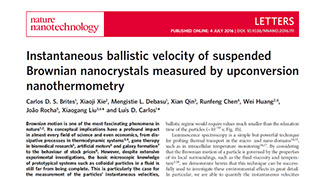
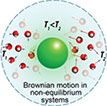
Implementing Thermometry on Silicon Surfaces Functionalized by Lanthanide-Doped Self-Assembled Polymer Monolayers
Advanced Functional Materials
"The thermometric functionalization of the Si surface with Tb3+ and Eu3+ complexes leads to a thermal sensitivity up to 1.43% K−1 , a cycle–recycle reliability of 98.6%, and a temperature uncertainty of less than 0.3 K. The functionalized surface presents reversible bistability that can be used as an optically active molecular demultiplexer."
HIGHLIGHTED IN THE COVER
ACCESS PAPER
Excitation of Magnetic Dipole Transitions at Optical Frequencies
Physical Review Letters
"We use the magnetic field distribution of an azimuthally polarized focused laser beam to excite a magnetic dipole transition in Eu3+ ions embedded in a Y2O3 NP. The absence of the electric field at the focus of an azimuthally polarized beam allows us to unambiguously demonstrate that the NP is excited by the magnetic dipole transition near 527.5 nm. When the laser wavelength is resonant with the magnetic dipole transition, the NP maps the local magnetic field distribution. "
ACCESS PAPER

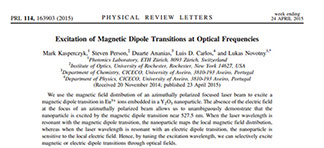
Joining Time-Resolved Thermometry and Magnetic-Induced Heating in a Single Nanoparticle Unveils Intriguing Thermal Properties at the Nanoscale
ACS Nano
"Here we demonstrate a successful realization of magnetically induced and optically temperature readout. The ratiometric thermometric probes are dual-emissive Eu3+/Tb3+ lanthanide complexes. Cells were incubated with the nanoparticles, and fluorescence microscopy permits the mapping of the intracellular local temperature".
ACCESS PAPER
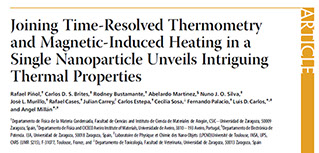

A High-Temperature Molecular Ferroelectric Zn/Dy Complex Exhibiting Single-Ion-Magnet Behavior and Lanthanide Luminescence
Angewandte Chemie
"Multifunctional molecular ferroelectrics are exciting materials synthesized using molecular chemistry concepts, which may combine a spontaneous electrical polarization, switched upon applying an electric field, with another physical property. We investigate the correlations between the electric polarization and the crystal structure as well as between the low-temperature magnetic slow relaxation and the optical properties."
ACCESS PAPER

Efficient and tuneable photoluminescent boehmite hybrid nanoplates lacking metal activator centres for single-phase white LEDs
Nature Communications
" Here we report a simple route to design high-efficient WLEDs by combining a commercial ultraviolet LED chip (InGaAsN, 390 nm) and boehmite (γ-AlOOH) hybrid nanoplates. Unusually high quantum yields (ηyield=38–58%) result from a synergic energy transfer between the boehmite-related states and the triplet states of the benzoate ligands bound to the surface of the nanoplates."
ACCESS PAPER
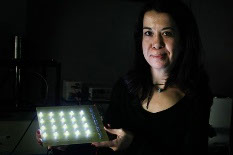

Back to Top
MADE BY PHANTOM-G, AVEIRO, PORTUGAL

